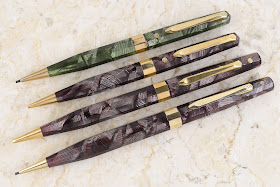This article has been edited and included in The Leadhead's Pencil Blog Volume 6, now on sale at The Legendary Lead Company. I have just a few hard copies left of the first printing, available here, and an ebook version in pdf format is available for download here.
If you don't want the book but you enjoy this article, please consider supporting the Blog project here.
It’s an Eversharp Doric, a series which was introduced in 1931 and went out with a whimper around 1940, after the introduction of the Skyline. There’s two generations of these, differentiated by the center bands and the clips. The different variations are shown on page 65 of The Catalogue:
The three on the left in this picture are first generation, and the other two are second generation. From the left, the first band is a first year example from 1931, with part of the band on the lower barrel and the rest on the upper barrel - that unique different appears in advertisements from the first year of production. Soon after the Doric was launched, Eversharp simplified the band by putting the entire thing on the upper barrel, as shown second from left, which remained unchanged until the Doric was redesigned in 1935. The example in the middle was from Eversharp’s “popular priced” Doric line, also from 1931-1935.
Beginning in 1935, the clips were redesigned; instead of a clip which was inserted through a slot in the barrel and secured inside with a screw, the new clips were simply stapled on from the outside. The bands were also redesigned; the lesser model pens had clips like the fourth one, and the pencils were designed to match – I also find this band on Doric advertising pencils, which were introduced late in the run. Eversharp’s flagship Dorics from 1935-1940 had the bands shown on the right, with triangular cutouts.
So why does this pencil have no cutouts? An example like this appears on page 68 of The Catalogue, along with a mention that there was some collector’s lore floating around that these were intended as special presentation pieces and the trim was rumored to be 14k – although the example I had at the time, pictured in the book, had wear on the corners that established it was only gold filled rather than 14k.
I presented a more plausible explanation here in 2014 (the full article isn’t online anymore, but you can find it in The Leadhead’s Pencil Blog Volume 3, page 29). David Isaacson had published an article in The Fountain Pen Journal about Wahl-made Gold Bond fountain pens, which included an advertisement showing piston-filler fountain pens with square cutouts in the bands, and cheaper lever-filled pens with solid bands. It makes sense to me that if Wahl was doing that sort of designation on pens it made for others, that it might also have made that distinction on its own lines.
That alternate view has not been universally accepted, and better documentary evidence has yet to surface which would explain what’s going on with these. Suffice to say it’s never made sense to me that a special presentation model would have simpler trim of base metal.
But I’m not here to rehash old arguments on a lazy Sunday – just providing the background to show you why I’m circling back around to these. I’ve turned up four examples to date:
And this new example establishes these came in three sizes:
The OCD collector in me breathes a sigh of relief that all three of these are in the same color, because it would drive me nuts to have three sizes but in two colors. I can handle the fact that the other sizes in green will probably turn up at some point. . . for now. As for other colors — I haven’t seen any.





Seems likely to me that these bands were intended for personalized engraving. That wouldn't necessitate their being solid gold by any means, given that such engraving was routinely offered on gold filled surfaces in penmakers' catalogs.
ReplyDelete